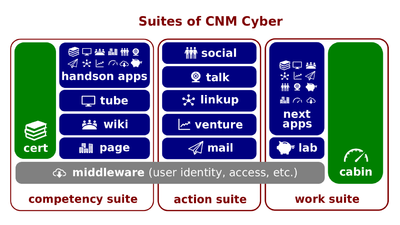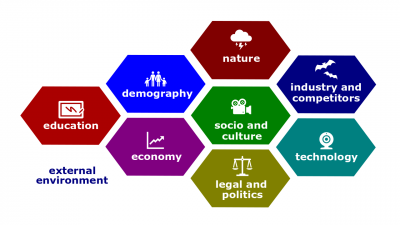Difference between revisions of "Surroundings of Projects"
(→Script) |
|||
| (67 intermediate revisions by 2 users not shown) | |||
| Line 1: | Line 1: | ||
| − | [[File:Cnm-digital.png|400px|thumb|right|[[ | + | [[File:Cnm-digital.png|400px|thumb|right|[[CNMCyber suite]]s]][[Surroundings of Projects]] (hereinafter, the ''Lectio'') is the [[lectio|lesson part]] of '''[[Project Work Essentials]]''' [[lesson]] that introduces its participants to [[project management]] concepts. This ''lesson'' belongs to the ''CNMCT Entrance'' section of [[CNMCyber Bootcamps]]. |
| Line 6: | Line 6: | ||
===Script=== | ===Script=== | ||
| − | : | + | :[[Project environment]]s are those natural and human-made surroundings in which those who work on a [[project]] perform. The most important ones are those surroundings that impact or may impact the [[project cost]], [[project timeline]], and/or [[work product]]. |
| − | : | + | :[[Project cost]]s are money that are spent to complete the project. [[Project budget]]s are those financial plans that estimate ''project costs''. Unexpected expenses, increased costs, or inability to pay on time may negatively impact the performance on a ''project''. |
| − | : | + | :[[Project timeline]]s are linear representations or displays of chronological order of project [[milestone]]s. [[Project schedule]]s are those temporal plans that estimate when the needed resources be received, [[work product]]s be completed, and [[deliverable]]s be shipped. |
| − | : | + | :A [[work product]] is a [[solution]], component of a solution, or any other output from any endeavor. Usually, a ''work product'' is a [[deliverable]], but not every ''work product'' becomes a ''deliverable''. A ''deliverable'' is any ''work product'' that one party has agreed to deliver to another. |
| − | : | + | :When it comes to development of ''work products'', the main question is whether this development is controllable. For instance, whether the raw materials or parts can be available on time. Or whether development requires special conditions such as [[security clearance]]s of the developers. Finally, whether developers generally know how to develop the ''work product''. |
| − | : | + | :The project surroundings are too diverse to have a single classification. Here, we will contrast [[internal environment|internal]] vs [[external environment|external]], as well as [[controllable environment|controllable]] vs [[uncontrollable environment]]s. |
| − | :[[ | + | :[[File:External-environment.png|400px|thumb|right|[[External environment]]]][[External environment]]s are ''environments'' beyond the borders of the [[enterprise]]. For instance, rapid changes in [[economy]], [[demography]], [[nature]], [[law]]s, [[industry]], and [[technology]] may positively or negatively impact [[project work]]s. |
| + | :[[Internal environment]]s are ''environments'' within the borders of the [[enterprise]]. They include [[project asset]]s and [[enterprise factor]]s. | ||
| − | [[ | + | :[[Project asset]]s are those organizational resources that a worker or a team can use while working on a [[project]]. The assets are not necessarily monetary. Contents of [[CNM Wiki]] are some of those resources. When you work on your task as a part of [[CNMCyber Team]], you can use any of those contents; you may also choose not to use any. |
| + | |||
| + | :[[Enterprise factor]]s are those conditions that direct and constrain [[project work]]; these conditions are imposed by either the [[organizational culture]]s or organizational [[workforce]]. When you work on a ''project'', these conditions are not under your immediate control. | ||
| + | |||
| + | :For example, [[CNMCyber Team]] uses [[CNM Wiki]] for its work on requirements. You may like it or not, but, if you work on requirements as a part of the ''Team'', you have to use the ''Wiki''. | ||
| + | |||
| + | :Similarly, you cannot change [[Personality|personalities]] of your teammates, their approaches to work, or even availability. People are people. They get sick, face family situations, and/or change their employment. | ||
| + | |||
| + | :However, environmental impacts on a ''project'' don't depend on whether sources of challenges are in ''external'' or ''internal'' environments. The impacts depend on whether the project's environment is [[controllable environment|controllable]] and, if it does, whether it is controlled. | ||
| + | |||
| + | :Project staffers cannot prevent anyone who works on the project from being sick, for instance, but if a backup plan exists, such a sickness will not be disruptive. | ||
| + | |||
| + | :[[Uncontrollable environment]]s cannot be certain and predictable. Vice versa, [[controllable environment]]s are so. However, it still takes a [[project coordinator]], [[project manager]], or someone else to make them controlled. | ||
===Key terms=== | ===Key terms=== | ||
| − | :[[ | + | :[[Project environment]], [[project cost]], [[project budget]], [[project timeline]], [[project schedule]], [[work product]], [[deliverable]], [[internal environment]], [[project asset]], [[enterprise factor]], [[external environment]], [[controllable environment]], [[uncontrollable environment]] |
===Closing=== | ===Closing=== | ||
| − | : | + | :Usage of [[CNM Agile]] framework for developments in [[CNMCyber]] can be best classified as: |
| + | <ol type="a"><li>[[Project asset]].</li><li>[[Enterprise factor]].</li><li>[[Project environment]].</li><li>All of the other substantive answers are correct.</li> | ||
| + | |||
| − | The successor [[lectio]] is '''[[ | + | The successor [[lectio]] is '''[[Stages of Project Work]]'''. |
==Presentations== | ==Presentations== | ||
Latest revision as of 02:57, 21 October 2023
Surroundings of Projects (hereinafter, the Lectio) is the lesson part of Project Work Essentials lesson that introduces its participants to project management concepts. This lesson belongs to the CNMCT Entrance section of CNMCyber Bootcamps.
Content
The predecessor lectio is Developments at the Wiki.
Script
- Project environments are those natural and human-made surroundings in which those who work on a project perform. The most important ones are those surroundings that impact or may impact the project cost, project timeline, and/or work product.
- Project costs are money that are spent to complete the project. Project budgets are those financial plans that estimate project costs. Unexpected expenses, increased costs, or inability to pay on time may negatively impact the performance on a project.
- Project timelines are linear representations or displays of chronological order of project milestones. Project schedules are those temporal plans that estimate when the needed resources be received, work products be completed, and deliverables be shipped.
- A work product is a solution, component of a solution, or any other output from any endeavor. Usually, a work product is a deliverable, but not every work product becomes a deliverable. A deliverable is any work product that one party has agreed to deliver to another.
- When it comes to development of work products, the main question is whether this development is controllable. For instance, whether the raw materials or parts can be available on time. Or whether development requires special conditions such as security clearances of the developers. Finally, whether developers generally know how to develop the work product.
- The project surroundings are too diverse to have a single classification. Here, we will contrast internal vs external, as well as controllable vs uncontrollable environments.
- External environments are environments beyond the borders of the enterprise. For instance, rapid changes in economy, demography, nature, laws, industry, and technology may positively or negatively impact project works.
- Internal environments are environments within the borders of the enterprise. They include project assets and enterprise factors.
- Project assets are those organizational resources that a worker or a team can use while working on a project. The assets are not necessarily monetary. Contents of CNM Wiki are some of those resources. When you work on your task as a part of CNMCyber Team, you can use any of those contents; you may also choose not to use any.
- Enterprise factors are those conditions that direct and constrain project work; these conditions are imposed by either the organizational cultures or organizational workforce. When you work on a project, these conditions are not under your immediate control.
- For example, CNMCyber Team uses CNM Wiki for its work on requirements. You may like it or not, but, if you work on requirements as a part of the Team, you have to use the Wiki.
- Similarly, you cannot change personalities of your teammates, their approaches to work, or even availability. People are people. They get sick, face family situations, and/or change their employment.
- However, environmental impacts on a project don't depend on whether sources of challenges are in external or internal environments. The impacts depend on whether the project's environment is controllable and, if it does, whether it is controlled.
- Project staffers cannot prevent anyone who works on the project from being sick, for instance, but if a backup plan exists, such a sickness will not be disruptive.
- Uncontrollable environments cannot be certain and predictable. Vice versa, controllable environments are so. However, it still takes a project coordinator, project manager, or someone else to make them controlled.
Key terms
- Project environment, project cost, project budget, project timeline, project schedule, work product, deliverable, internal environment, project asset, enterprise factor, external environment, controllable environment, uncontrollable environment
Closing
- Project asset.
- Enterprise factor.
- Project environment.
- All of the other substantive answers are correct.
The successor lectio is Stages of Project Work.

